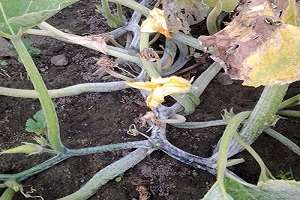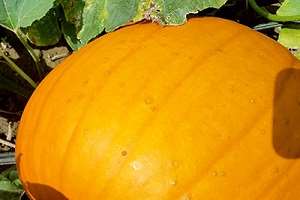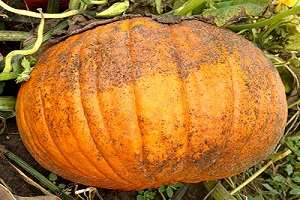- Inspire Super (16-20 ounces per acre, seven-day PHI, FRAC 9 and 3)
- Pristine 39WG (12.5-18.5 ounces per acre, zero-day PHI, FRAC 7 and 11)
- Procure 50WS (4-8 ounces per acre, zero -day PHI, FRAC 3)
- Quintec (4-6 ounces per acre, three-day PHI, FRAC 13)
- Rally 40W (2.5-5.0 ounces per acre, one-day PHI, FRAC 3)
- Torino (3.4 ounces per acre, zero -day PHI, FRAC U6)

Fruit rots
Fruit rots developed in some fields triggered by the frequent rains in August. This is usually caused by a Phytophthora population in the field. Whenever it makes sense for your customer-base, avoid the round-stemmed Cucurbita maxima species in fields that are known to have a history of Phytophthora, as they are very susceptible to fruit rots. The ridge-stemmed Cucurbita pepo and Cucurbita moschata species have some level of age-related resistance that can allow older fruit to hold off the rots longer than younger fruit. This is probably why we’ve gotten more reports about rotting in later planted, small-fruited hard squashes since they were still young during the August rains, and pumpkins were further along in their fruit growth.
Worth spraying now? NO. Michigan State University Extension and AgBioResearch trials found that a preventative application at fruit set and a second application 14 days later was an effective measure for managing this disease. If wet conditions persist, another application may be necessary. A minimum of 40 gallons per acre with a boom sprayer or an air blast sprayer is best to penetrate the canopy and make contact with the fruit itself. A soil drench is ineffective for fruit rots. Rotation away from other fruiting vegetables, including beans and peas, is extremely important for preventing this disease from spreading each year.
What to use? The following products are effective against Phytophthora when applied proactively, and rotated:
- Forum 4.18SC (6 ounces per acre, zero-day PHI, FRAC 40)
- Gavel 75DF (1.5-2.0 ounces per acre, five-day PHI, FRAC M3 and 22)
- Orondis Ultra (4-8 ounces per acre, zero-day PHI, FRAC U15, and 40)
- Presidio 4SC (3-4 ounces per acre, two-day PHI, FRAC 7 and 11)
- Revus 2.09SC (8 ounces per acre, zero-day PHI, FRAC 40)
- Zampro (14 ounces per acre, zero-day PHI, FRAC 45 and 40)
Fruit spots
Fruit spots are being noticed in some fields. These spots are probably due to angular leaf spot and bacterial leaf spot, both caused by seed borne bacteria. However, once established in a field, that field should be planted to other crops for two to three years. Mild cases are not much of a concern, but in severe situations, the spots can coalesce and lead to fruit rot. For more information, refer to “Bacterial disease of pumpkins: An old enemy and an emerging bacterial disease” by MSU Extension.
Worth spraying now? NO. Control at this time is of no value. Preventative application of copper formulations can reduce severity of disease development, and is more effective than sprays after symptoms have developed. MSU Extension suggests spraying fruit when softball-sized until fruit set is complete.
What to use? Different copper formulations are available, but for all products, the tank-mix solution should be in a pH range of 6.5 to 8 to decrease the risk of phytotoxicity in vine crops. Bacteria can develop resistance to the copper mode of action (FRAC M1). Alternate and tank-mix with other products, such as:
- Mancozeb (various formulations, five-day PHI, FRAC M3)
- Actigard 50WG (0.5-1.0 ounces per acre, zero-day PHI, FRAC 21)
- Tanos (8-10 ounces per acre, three-day PHI, 32 ounces maximum per acre per season, FRAC 27, 11)
- Serenade Maximum WP (1-3 pounds per acre, zero-day PHI, FRAC 44)

Cucumber beetles and squash bugs
Cucumber beetles and squash bugs are very damaging to seedlings, and control is most important just after planting. Mid-season growth is more tolerant of feeding damage, but plants can be impacted by bacterial wilt disease transferred by the beetles, and cucurbit yellow vine disease from squash bugs. If plants have made it this far, the last remaining impact they can have is fruit rind and stem feeding.
Worth spraying now? MAYBE. A lot depends on when you are going to harvest. If the fruit is orange and ready, save yourself some money and just harvest. Control would only be necessary if you have a significant number of fruit in the green to orange transition phase and live in the southern tier of counties, and damage can be readily found.
What to use? Pyrethroids are the primary mode of action (IRAC 3A) for handling these pests mid-season:
- Ambush 2EC (3.2-12.8 ounces per acre, zero-day PHI, 6.4 pounds maximum per season, RUP, IRAC 3A)
- Assail 30SG (2.5-5.3 ounces per acre, zero-day PHI, five applications maximum per season, IRAC 4A)
- Brigade 2EC (2.6-6.4 ounces per acre, three-day PHI, 19.2 ounces maximum per season, RUP, IRAC 3A)
- Mustang Maximumx (2.8-4 ounces per acre, one-day PHI, 24 ounces maximum per season, IRAC 3A)
- Pounce 25WP (6.4-12.8 ounces per acre, zero-day PHI, 4.8 pounds maximum per season, RUP, IRAC 3A)
- Warrior II (1.28-1.92 ounces per acre, one-day PHI, 11.5 ounces maximum per season, RUP, IRAC 3A)
Aphids
Aphids have not been a major issue for many growers this year. However, they are a major vector for viruses, which twist foliage and makes odd-shaped fruit if they transfer the virus before pollination and fruit set. If aphids colonize after fruit set, the primary issue is defoliation and the sugary honeydew they drop onto developing fruit. This sugar gets colonized by a black sooty mold. The mold does not infest the pumpkin, but makes post-harvest cleaning more important.
Worth spraying now? PROBABLY NOT. Unless your vines and fruits are still green, it will not be economical to spray them now so close to harvest. If they are in the field in low numbers right now, then lady beetles, hover flies and parasitic wasps will handle them from here to the end of October. If colonies have grown to form hotspots in your field, then a couple of weeks ago would have been more appropriate timing.
What to use? Scouting and spot treatments can save money by preventing their spread and future field-wide applications. The following products are applied to the foliage:
- Actara 25WDG (1.5-3 ounces per acre, zero-day PHI, IRAC 4A)
- Assail 30SG (2.5-4 ounces per acre, zero -day PHI, five applications maximum per season, IRAC 4A)
- Beleaf 50SG (2-2.8 ounces per acre, zero -day PHI, IRAC 9C)
- Exirel 0.83E (13.5-20.5 ounces per acre, one-day PHI, IRAC 28)
- Fulfill 50WDG (2.75 ounces per acre, zero -day PHI, 5.5 ounces maximum per season, IRAC 9B)
- Malathion 5EC (1.5-2.8 pints per acre, one-day PHI, IRAC 1B)
- Warrior II (1.28-1.92 ounces per acre, one-day PHI, 11.5 ounces maximum per season, RUP, IRAC 3A)
The following products can be used through drip irrigation lines if a field-scale outbreak occurs early in the season:
- Admire PRO 4.6DF (7.0-10.5 ounces per acre, 21-day PHI, 10.5 ounces maximum per season, IRAC 4A)
- Platinum (5-11 ounces per acre, 30-day PHI, IRAC 4A)
- Sivanto 200SL (21-28 ounces per acre, 21-day PHI, IRAC 4D)
- Verimark 1.67SC (10.0-13.5 ounces per acre, one-day PHI, IRAC 28)

Picking and marketing
This is going to be your main focus now until Oct. 31. If the fruit is orange and the leaves are dying, it is best to harvest. Getting them out of the field and into shade will prevent sunburn, insect infestation and possibly some fruit rots. Cut them from the vines and clean off as much soil as you can. If you suspect fruit rots may become an issue, it would be best to place them in a 10 percent chlorine dip if you can. This will not guarantee the fruit will not rot since some fruit rots can be systemic. Consider avoiding harvest in wet areas completely or keep that fruit separate from fruit harvested from other areas of the field. This will minimize fruit-to-fruit contamination.
Remember, “Volume sells.” People are attracted to large displays, so keep them well stocked. Especially make sure to have displays in great shape for the weekend. This is even more critical if the weather is expected to be nice. There is a direct correlation between nice weekend weather in October and pumpkin sales. You will have left overs come Nov. 1 when the price drops. Just consider that as one of the costs of doing business.
The overriding message in this article is to not get the urge to go into coasting mode for the next four weeks. You have brought your pumpkins through a lot over the past four months, so to give up now might mean the difference between a good year and a great year.
Source: msu.edu